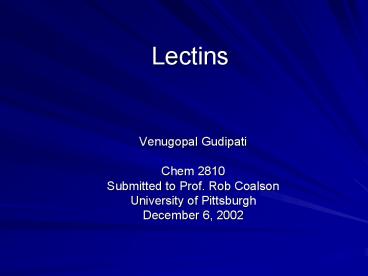Lectins PowerPoint PPT Presentation
1 / 11
Title: Lectins
1
Lectins
- Venugopal Gudipati
- Chem 2810
- Submitted to Prof. Rob Coalson
- University of Pittsburgh
- December 6, 2002
2
Lectins
- Lectins are glycoproteins or carbohydrate binding
proteins having agglutinating property. - Lectins were first found in plants and were
latter isolated from animals as well. - Interaction of lectins with carbohydrates is very
specific. - Lectin-carbohydrate interactions are comparable
to enzyme-substrate, or antigen-antibody
interactions. - Their specificity to particular sugar is defined
by the mono-or-oligosaccharide that inhibits the
agglutination completely.
3
Animal Lectins
- Animal lectins are complex, multidomain proteins.
- Their sugar binding activity results from a
particular domain called Carbohydrate Recognition
Domain (CRD). - Animal lectins are broadly classified into the
following categories - a Calnexin and L-type lectin- both function as
protein sorters in the endoplasmic reticulum.
4
b C-type Lectins
- C-type Lectins Contain Ca2 that stabilizes the
local conformation of the protein by making
coordinate bonds to the surface of the protein
and key hydroxyl groups of the sugar ring. - Function Provide the sugar recognition activity
in a variety of cell surfaces, initiate
biological processes such as adhesion,
endocytosis and complement fixation. - Amino acid residues that coordinate the Ca2 also
make hydrogen bonds to the sugar hydroxyl groups.
The specific orientation of sugar binding is
further directed by the hydrophobic interactions.
5
C-type lectin domain
6
Other Lectin categories
7
Plant Lectins
- Lectins, with a molecular weight of
60,000-100,000 MW, are present in various plants. - Their functions in plants include, enzymatic
activity, storage of proteins, defense mechanism,
cell wall extension, mitogenic stimulation,
transport of carbohydrates and packaging and
mobilization of storage materials. - Most important function of plant lectins include
binding of nitrogen fixing bacteria to the legume
roots. The symbiotic specificity of the Rhizobium
to specific species of plant is governed by
lectin interactions. - Biological activity of many lectins can be
attributed to metal ions which are important
components of the native structure of most
leguminous lectins. - Many of the plant lectins are toxic in nature.
They primarily effect gastrointestinal tract,
cell membrane, and other organelles.
8
Structural basis for the recognition of sugars
- Con A was the first lectin to be crystallized and
analyzed by X-ray diffraction. X-ray analysis
gave valuable insight of the folded conformation
of lectins and their sugar binding specificity. - Many of the legume lectins contain one or two
chains, with a very similar three dimentional
structure. In general, they contain a curved
seven-stranded b-sheet and a flat six-stranded
b-sheet interconnected by turns and loops to
form a flat domed shape structure. - Most legume lectins contain two protomers that
interact with each other in a two fold symmetry
(Figure 2).
- Dimerization creates a 12-stranded b-sandwich in
which the two faces of monomers associate by
their flat bottoms. - Figure 2
9
Structural basis for the recognition of sugars
cont,.
- Interaction of lectins with sugars, which is
responsible for the carbohydrate-binding
specificity of the lectins, depends on the
presence of a monosaccharide binding site at the
surface of lectin monomer. - Example Co-crystallization of ConA with
D-mannose and D-glucose has shown that amino acid
residues at the top of the domain shaped lection
monomer form a monosaccharide binding site
responsible for the specific recognition of sugar
by lectin.
- These residues (Asp81, Gly99, Asn125, Gly29,
Ala30, and Glu31 in LoLI) form a network of seven
hydrogen bonds with O3, O4, O5 and O6 of the
simple sugar (Figure 3). - Figure 3
10
NMR investigation of protein-carbohydrate
interaction
- Protein-carbohydrate interactions have been
frequently studied by X-ray crystal analysis of
protein-carbohydrate complexes. - NMR studies were less suitable for the studies
with lectins of high molecular mass, but are
generally employed in case of simple lectins,
which provides valuable insight of the driving
forces behind protein-carbohydrate interactions
in solution. - Hevein domain was studies by NMR investigations.
Hevein inhibits the growth of chitin-containing
fungi protecting plants from the attack of vide
range of potential pathogens.
- Ligand binding studies of WGA-B (Wheat gram
agglutinin) in presence of increasing amounts of
chitotriose were carried out by monitoring 1D
1H-NMR spectrum (Figure 4). - The observed effects of chemical shifts and line
broadening indicate that the interaction is fast
in NMR time scale thus allowing the chemical
shift values in determination of equilibrium
constants.
11
References
- Damme, E. J. M. V., Peumans, W. J., Barre, A.,
Rouge. (1998) Plant Lectins A Composite of
Several Distinct Families of Structurally and
Evolutionally Related Proteins with Diverse
Biological Roles. Crystal Reviews in Plant
Sciences. 17, 575-692. - Espinosa, J. F., Asensio, Garcia, J. L., Laynez,
J., Bruix, M., Wright, C., Siebert, H-C., Gabius,
H-J., Canada, F. J., Barbero, J. J. (2000) Eur.
J. Biochem. 267, 3965-3978. - http//ctld.glycob.ox.ac.uk/ctld/lectins.html
- http//www.ansci.cornell.edu/plants/toxicagents/le
ctins/lectins.html

